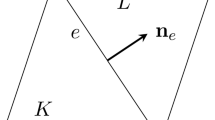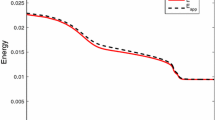Abstract
This paper establishes a structure-preserving numerical scheme for the Cahn–Hilliard equation with degenerate mobility. First, by applying a finite volume method with upwind numerical fluxes to the degenerate Cahn–Hilliard equation rewritten by the scalar auxiliary variable (SAV) approach, we creatively obtain an unconditionally bound-preserving, energy-stable and fully-discrete scheme, which, for the first time, addresses the boundedness of the classical SAV approach under \(H^{-1}\)-gradient flow. Then, a dimensional-splitting technique is introduced in high-dimensional cases, which greatly reduces the computational complexity while preserves original structural properties. Numerical experiments are presented to verify the bound-preserving and energy-stable properties of the proposed scheme. Finally, by applying the proposed structure-preserving scheme, we numerically demonstrate that surface diffusion is approximated by the Cahn–Hilliard equation with degenerate mobility and Flory–Huggins potential, when the absolute temperature is sufficiently low, which agrees well with the theoretical result by using formal asymptotic analysis.















Similar content being viewed by others
Data availability
The code for the current study is available from the corresponding author on reasonable request.
References
Acosta-Soba, D., Guillén-González, F., Rodríguez-Galván, J.R.: An upwind DG scheme preserving the maximum principle for the convective Cahn–Hilliard model. Numer. Algorithms 92, 1589–1619 (2023)
Alikakos, N.D., Bates, P.W., Chen, X.: Convergence of the Cahn–Hilliard equation to the Hele–Shaw model. Arch. Ration. Mech. Anal. 128, 165–205 (1994)
Backofen, R., Wise, S.M., Salvalaglio, M., Voigt, A.: Convexity splitting in a phase field model for surface diffusion. Int. J. Numer. Anal. Mod. 16, 192–209 (2019)
Bailo, R., Carrillo, J.A., Kalliadasis, S., Perez, S.P.: Unconditional bound-preserving and energy-dissipating finite-volume schemes for the Cahn–Hilliard equation. Commun. Comput. Phys. 34, 713–748 (2023)
Barrett, J.W., Blowey, J.F., Garcke, H.: Finite element approximation of the Cahn–Hilliard equation with degenerate mobility. SIAM J. Numer. Anal. 37, 286–318 (1999)
Bertozzi, A.L., Esedoglu, S., Gillette, A.: Inpainting of binary images using the Cahn–Hilliard equation. IEEE Trans. Image Process. 16, 285–291 (2007)
Bessemoulin-Chatard, M., Filbet, F.: A finite volume scheme for nonlinear degenerate parabolic equations. SIAM J. Sci. Comput. 34, B559–B583 (2012)
Bretin, E., Masnou, S., Sengers, A., Terii, G.: Approximation of surface diffusion flow: a second order variational Cahn–Hilliard model with degenerate mobilities. Math. Mod. Methods Appl. Sci. 32, 793–829 (2022)
Brown, G., Chakrabarti, A.: Surface-directed spinodal decomposition in a two-dimensional model. Phys. Rev. A 46, 4829–4835 (1992)
Burger, M., He, L., Schönlieb, C.-B.: Cahn–Hilliard inpainting and a generalization for gray value images. SIAM J. Imaging Sci. 2, 1129–1167 (2009)
Cahn, J.W., Elliott, C.M., Novickcohen, A.: The Cahn–Hilliard equation with a concentration dependent mobility: motion by minus the Laplacian of the mean curvature. Eur. J. Appl. Math. 7, 287–301 (1996)
Cahn, J.W., Hilliard, J.E.: Free energy of a nonuniform system. I. Interfacial free energy. J. Chem. Phys. 28, 258–267 (1958)
Cahn, J.W., Taylor, J.E.: Surface motion by surface diffusion. Acta Metall. Mater. 42, 1045–1063 (1994)
Chen, W., Wang, C., Wang, X., Wise, S.M.: Positivity-preserving, energy stable numerical schemes for the Cahn–Hilliard equation with logarithmic potential. J. Comput. Phys. X 3, 100031 (2019)
Chen, C., Yang, X.: Fast, provably unconditionally energy stable, and second-order accurate algorithms for the anisotropic Cahn–Hilliard model. Comput. Methods Appl. Mech. Eng. 351, 35–59 (2019)
Cheng, Q., Liu, C., Shen, J.: A new Lagrange multiplier approach for gradient flows. Comput. Methods Appl. Mech. Eng. 367, 113070 (2020)
Cheng, Q., Shen, J.: A new Lagrange multiplier approach for constructing structure preserving schemes, I. Positivity preserving. Comput. Methods Appl. Mech. Eng. 391, 114585 (2022)
Cheng, Q., Shen, J.: A new Lagrange multiplier approach for constructing structure preserving schemes, II. Bound preserving. SIAM J. Numer. Anal. 60, 970–998 (2022)
Coppersmith, D., Winograd, S.: Matrix multiplication via arithmetic progressions. J. Symb. Comput. 9, 251–280 (1990)
Cox, S.M., Matthews, P.C.: Exponential time differencing for stiff systems. J. Comput. Phys. 176, 430–455 (2002)
Dai, S., Du, Q.: Weak solutions for the Cahn–Hilliard equation with degenerate mobility. Arch. Ration. Mech. Anal. 219, 1161–1184 (2016)
Dong, L., Wang, C., Zhang, H., Zhang, Z.: A positivity-preserving, energy stable and convergent numerical scheme for the Cahn–Hilliard equation with a Flory–Huggins–deGennes energy. Commun. Math. Sci. 17, 921–939 (2019)
Du, Q., Ju, L., Li, X., Qiao, Z.: Maximum bound principles for a class of semilinear parabolic equations and exponential time-differencing schemes. SIAM Rev. 63, 317–359 (2021)
Du, Q., Nicolaides, R.A.: Numerical analysis of a continuum model of phase transition. SIAM J. Numer. Anal. 28, 1310–1322 (1991)
Elliott, C.M., Garcke, H.: On the Cahn–Hilliard equation with degenerate mobility. SIAM J. Math. Anal. 27, 404–423 (1996)
Eyre, D.J.: Unconditionally gradient stable time marching the Cahn–Hilliard equation. Mater. Res. Soc. Symp. Proc. 529, 39–46 (1998)
Fu, Z., Yang, J.: Energy-decreasing exponential time differencing Runge–Kutta methods for phase-field models. J. Comput. Phys. 454, 110943 (2022)
Garcke, H., Lam, K.F., Nürnberg, R., Sitka, E.: A multiphase Cahn–Hilliard–Darcy model for tumour growth with necrosis. Math. Methods Appl. Sci. 28, 525–577 (2018)
Gong, Y., Hong, Q., Wang, Q.: Supplementary variable method for thermodynamically consistent partial differential equations. Comput. Methods Appl. Mech. Eng. 381, 113746 (2021)
Gottlieb, S., Shu, C.-W., Tadmor, E.: Strong stability-preserving high-order time discretization methods. SIAM Rev. 43(1), 89–112 (2001)
Hong, Q., Li, J., Wang, Q.: Supplementary variable method for structure-preserving approximations to partial differential equations with deduced equations. Appl. Math. Lett. 110, 106576 (2020)
Huang, Q.-A., Jiang, W., Yang, J.Z.: An unconditionally energy stable scheme for simulating wrinkling phenomena of elastic thin films on a compliant substrate. J. Comput. Phys. 388, 123–143 (2019)
Huang, Q.-A., Jiang, W., Yang, J.Z.: An efficient and unconditionally energy stable scheme for simulating solid-state dewetting of thin films with isotropic surface energy. Commun. Comput. Phys. 26, 1444–1470 (2019)
Huang, Q.-A., Jiang, W., Yang, J.Z., Zhang, G.: Linear multi-step methods and their numerical stability for solving gradient flow equations. Adv. Comput. Math. 49, 39 (2023)
Huang, F., Shen, J., Wu, K.: Bound/positivity preserving and unconditionally stable schemes for a class of fourth order nonlinear equations. J. Comput. Phys. 460, 111177 (2022)
Huang, F., Shen, J., Yang, Z.: A highly efficient and accurate new scalar auxiliary variable approach for gradient flows. SIAM J. Sci. Comput. 42, A2514–A2536 (2020)
Huang, J., Yang, C., Wei, Y.: Parallel energy-stable solver for a coupled Allen–Cahn and Cahn–Hilliard system. SIAM J. Sci. Comput. 42, C294–C312 (2020)
Ipocoana, E.: On a non-isothermal Cahn–Hilliard model for tumor growth. J. Math. Anal. Appl. 506, 125665 (2022)
Jiang, W., Bao, W., Thompson, C.V., Srolovitz, D.J.: Phase field approach for simulating solid-state dewetting problems. Acta Mater. 60, 5578–5592 (2012)
Jiang, M., Zhang, Z., Zhao, J.: Improving the accuracy and consistency of the scalar auxiliary variable (SAV) method with relaxation. J. Comput. Phys. 456, 110954 (2022)
Jiang, W., Zhao, Q.: Sharp-interface approach for simulating solid-state dewetting in two dimensions: a Cahn–Hoffman \({\varvec {\xi }}\)-vector formulation. Physica D 390, 69–83 (2019)
Ju, L., Li, X., Qiao, Z.: Stabilized exponential-SAV schemes preserving energy dissipation law and maximum bound principle for the Allen–Cahn type equations. J. Sci. Comput. 92, 66 (2022)
Ju, L., Li, X., Qiao, Z.: Generalized SAV-exponential integrator schemes for Allen–Cahn type gradient flows. SIAM J. Numer. Anal. 60, 1905–1931 (2022)
Jüngel, A.: A positivity-preserving numerical scheme for a nonlinear fourth order parabolic system. SIAM J. Numer. Anal. 39, 385–406 (2001)
Lee, A.A., Münch, A., Süli, E.: Sharp-interface limits of the Cahn–Hilliard equation with degenerate mobility. SIAM J. Appl. Math. 76, 433–456 (2016)
Li, J., Ju, L., Cai, Y., Feng, X.: Unconditionally maximum bound principle preserving linear schemes for the conservative Allen–Cahn equation with nonlocal constraint. J. Sci. Comput. 87, 98 (2021)
Li, B., Yang, J., Zhou, Z.: Arbitrarily high-order exponential cut-off methods for preserving maximum principle of parabolic equations. SIAM J. Sci. Comput. 42, A3957–A3978 (2020)
Liao, H.-L., Tang, T., Zhou, T.: On energy stable, maximum-principle preserving, second-order BDF scheme with variable steps for the Allen–Cahn equation. SIAM J. Numer. Anal. 58, 2294–2314 (2020)
Liu, Z., Li, X.: The exponential scalar auxiliary variable (E-SAV) approach for phase field models and its explicit computing. SIAM J. Sci. Comput. 42, B630–B655 (2020)
Lu, C., Huang, W., Vleck, E.S.V.: The cutoff method for the numerical computation of nonnegative solutions of parabolic PDEs with application to anisotropic diffusion and Lubrication-type equations. J. Comput. Phys. 242, 24–36 (2013)
Müller, G., Schwahn, D., Eckerlebe, H., Rieger, J., Springer, T.: Deviation of early stage of spinodal decomposition from the Cahn–Hilliard–Cook theory observed in an isotopic polymer blend. Physica B 234–236, 245–246 (1997)
Mullins, W.W., Sekerka, R.F.: Morphological stability of a particle growing by diffusion or heat flow. J. Appl. Phys. 34, 323–329 (1963)
Park, J.-H., Salgado, A.J., Wise, S.M.: Benchmark computations of the phase field crystal and functionalized Cahn–Hilliard equations via fully implicit. Nesterov accelerated schemes. Commun. Comput. Phys. 33, 367–398 (2023)
Pego, R.L.: Front migration in the nonlinear Cahn–Hilliard equation. Proc. R. Soc. Lond. A 422, 261–278 (1989)
Pesce, C., Muench, A.: How do degenerate mobilities determine singularity formation in Cahn–Hilliard equations? Multiscale Model. Simul. 19, 1143–1166 (2021)
Shen, J., Xu, J., Yang, J.: The scalar auxiliary variable (SAV) approach for gradient flows. J. Comput. Phys. 353, 407–416 (2018)
Shen, J., Xu, J., Yang, J.: A new class of efficient and robust energy stable scheme for gradient flows. SIAM Rev. 61, 474–506 (2019)
Strassen, V.: Gaussian elimination is not optimal. Numer. Math. 13, 354–356 (1969)
Tang, T., Yang, J.: Implicit-explicit scheme for the Allen–Cahn equation preserves the maximum principle. J. Comput. Math. 34, 451–461 (2016)
Tang, T., Yu, H., Zhou, T.: On energy dissipation theory and numerical stability for time-fractional phase-field equations. SIAM J. Sci. Comput. 41, A3757–A3778 (2019)
Yan, J., Shu, C.-W.: A local discontinuous Galerkin method for KdV type equations. SIAM J. Numer. Anal. 40(2), 769–791 (2002)
Yang, J., Yuan, Z., Zhou, Z.: Arbitrarily high-order maximum bound preserving schemes with cut-off postprocessing for Allen–Cahn equations. J. Sci. Comput. 90, 76 (2022)
Yang, X., Zhao, J.: On linear and unconditionally energy stable algorithms for variable mobility Cahn–Hilliard type equation with logarithmic Flory–Huggins potential. Commun. Comput. Phys. 25, 703–728 (2019)
Acknowledgements
The numerical calculations in this paper have been done on the supercomputing system in the Supercomputing Center of Wuhan University.
Funding
This work was partially supported by the National Natural Science Foundation of China (Nos. 12001210, 12131010, 12271414, 11871384, 12125103, 12071362, 12301558).
Author information
Authors and Affiliations
Corresponding author
Ethics declarations
Conflict of interest
The authors declare no competing interests.
Additional information
Publisher's Note
Springer Nature remains neutral with regard to jurisdictional claims in published maps and institutional affiliations.
Rights and permissions
Springer Nature or its licensor (e.g. a society or other partner) holds exclusive rights to this article under a publishing agreement with the author(s) or other rightsholder(s); author self-archiving of the accepted manuscript version of this article is solely governed by the terms of such publishing agreement and applicable law.
About this article
Cite this article
Huang, QA., Jiang, W., Yang, J.Z. et al. A Structure-Preserving, Upwind-SAV Scheme for the Degenerate Cahn–Hilliard Equation with Applications to Simulating Surface Diffusion. J Sci Comput 97, 64 (2023). https://doi.org/10.1007/s10915-023-02380-6
Received:
Revised:
Accepted:
Published:
DOI: https://doi.org/10.1007/s10915-023-02380-6




